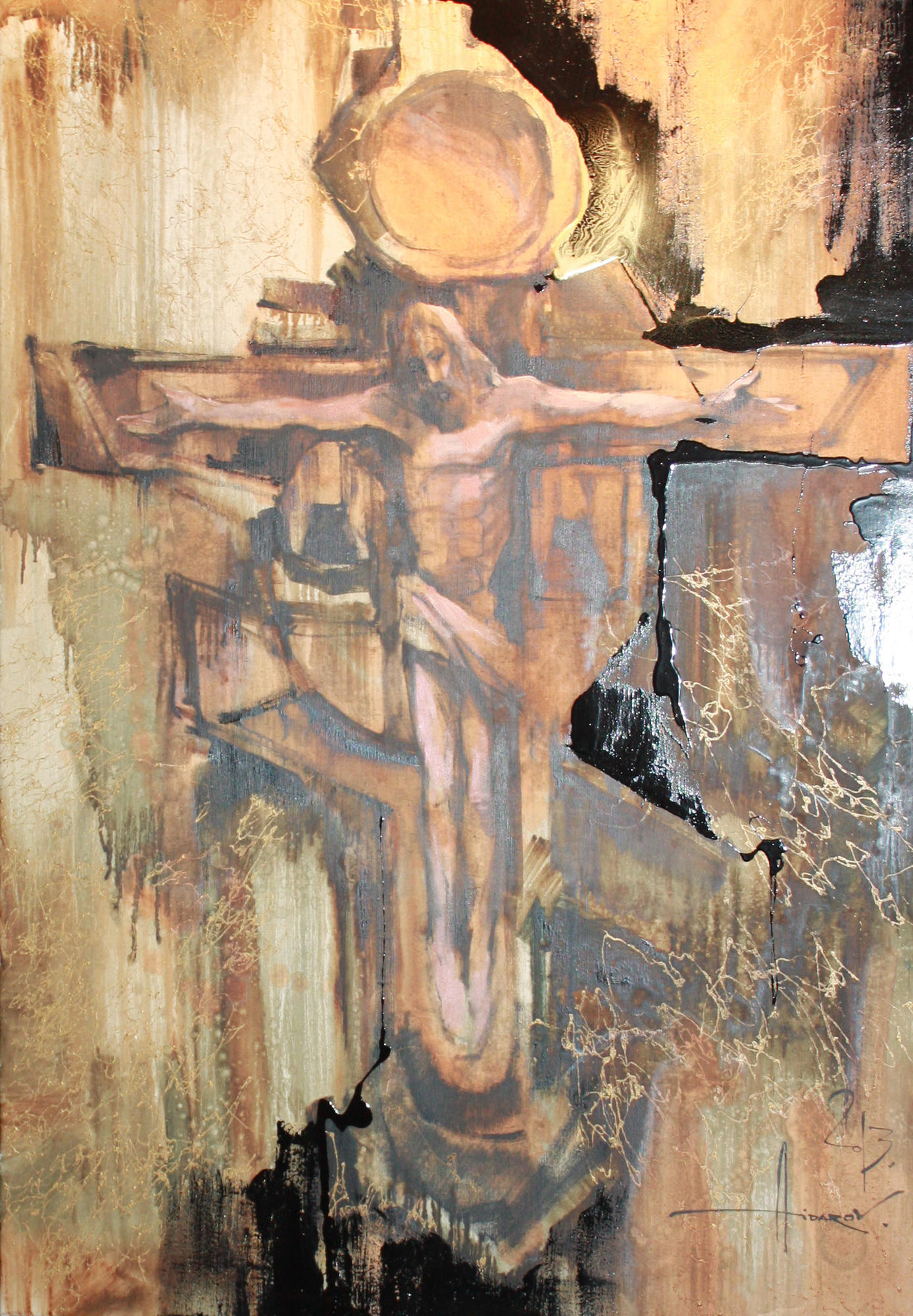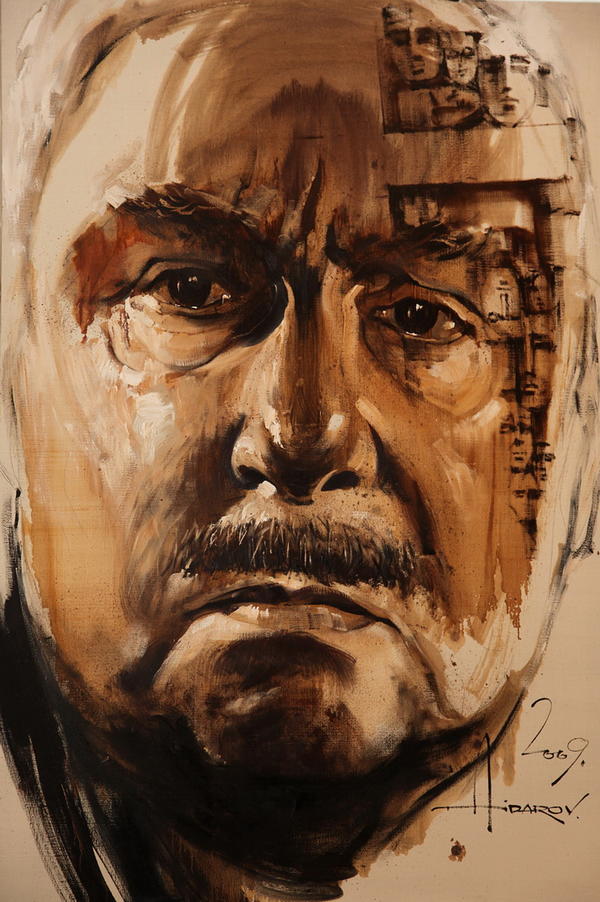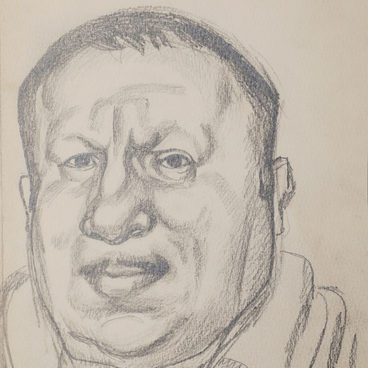The portrait of Ernst Neizvestny (oil on canvas) was created by artist Ilyas Aidarov (born 1956) in 2009. The original copy was donated to the museum in 2013.
Aidarov in his work created an intellectual image of the sculptor by focusing on psychologism. The symbols of Ernst Nezvestny’s oeuvre, if you follow the internal logic of the portrait, there is a consequence of both deep mental efforts and intuitive insights. The second part of the diptych is stored in the museum.
Ilyas Aidarov is an Honored Artist of Russia, People’s Artist of the Republic of Tatarstan. Participant of more than 80 exhibitions, winner of the Second Moscow International Art Festival Traditions and Contemporaneity. His works are kept in private collections around the world.
This is the first artist in the history of mankind to hold an exhibition of his works on the space orbit. A personal art exhibition was held aboard the International Space Station in 2002. The artist’s paintings orbited the Earth several times! And all because they were taken into space by the commander of the ship Sergey Zaletin. Thanks to this exhibition, Ilyas Aidarov was listed in the Guinness Book of Records.
The works of Ilyas Aidarov are diverse - paintings and graphics, a mixture of styles and genres. In his portraits, the master seems to mix reality and fiction, not only transfers the person’s face to the canvas, but also manages to convey his thoughts and feelings. A story is perceived behind each portrait.
Ernst Neizvestny turned out on the portrait as he was in the last years of his life. A calm look, tightly pressed lips, the forehead wrinkled in concentrated work - all these features can be traced to the difficult fate of the famous sculptor. Ernst Iosifovich was too extraordinary, too avant-garde for his time. And even if during the short ‘thaw’ period his work was still accepted, although it was subjected to harsh criticism, after the meeting with Khrushchev at the exhibition in the Manege in 1962, Neizvestny had to go through several very difficult years.
Khrushchev criticized the work of the sculptor, so he stopped receiving orders. For many years he was left with no work, scratching along with casual earnings, sometimes even had to earn money as a loader. Neizvestny’s workshop was broken into several times, his work was stolen and then destroyed, he himself was beaten on the street. Life began to improve only after moving in 1976: first to Zurich, and then to the USA, where the master’s works finally gained well-deserved popularity.
Aidarov in his work created an intellectual image of the sculptor by focusing on psychologism. The symbols of Ernst Nezvestny’s oeuvre, if you follow the internal logic of the portrait, there is a consequence of both deep mental efforts and intuitive insights. The second part of the diptych is stored in the museum.
Ilyas Aidarov is an Honored Artist of Russia, People’s Artist of the Republic of Tatarstan. Participant of more than 80 exhibitions, winner of the Second Moscow International Art Festival Traditions and Contemporaneity. His works are kept in private collections around the world.
This is the first artist in the history of mankind to hold an exhibition of his works on the space orbit. A personal art exhibition was held aboard the International Space Station in 2002. The artist’s paintings orbited the Earth several times! And all because they were taken into space by the commander of the ship Sergey Zaletin. Thanks to this exhibition, Ilyas Aidarov was listed in the Guinness Book of Records.
The works of Ilyas Aidarov are diverse - paintings and graphics, a mixture of styles and genres. In his portraits, the master seems to mix reality and fiction, not only transfers the person’s face to the canvas, but also manages to convey his thoughts and feelings. A story is perceived behind each portrait.
Ernst Neizvestny turned out on the portrait as he was in the last years of his life. A calm look, tightly pressed lips, the forehead wrinkled in concentrated work - all these features can be traced to the difficult fate of the famous sculptor. Ernst Iosifovich was too extraordinary, too avant-garde for his time. And even if during the short ‘thaw’ period his work was still accepted, although it was subjected to harsh criticism, after the meeting with Khrushchev at the exhibition in the Manege in 1962, Neizvestny had to go through several very difficult years.
Khrushchev criticized the work of the sculptor, so he stopped receiving orders. For many years he was left with no work, scratching along with casual earnings, sometimes even had to earn money as a loader. Neizvestny’s workshop was broken into several times, his work was stolen and then destroyed, he himself was beaten on the street. Life began to improve only after moving in 1976: first to Zurich, and then to the USA, where the master’s works finally gained well-deserved popularity.




